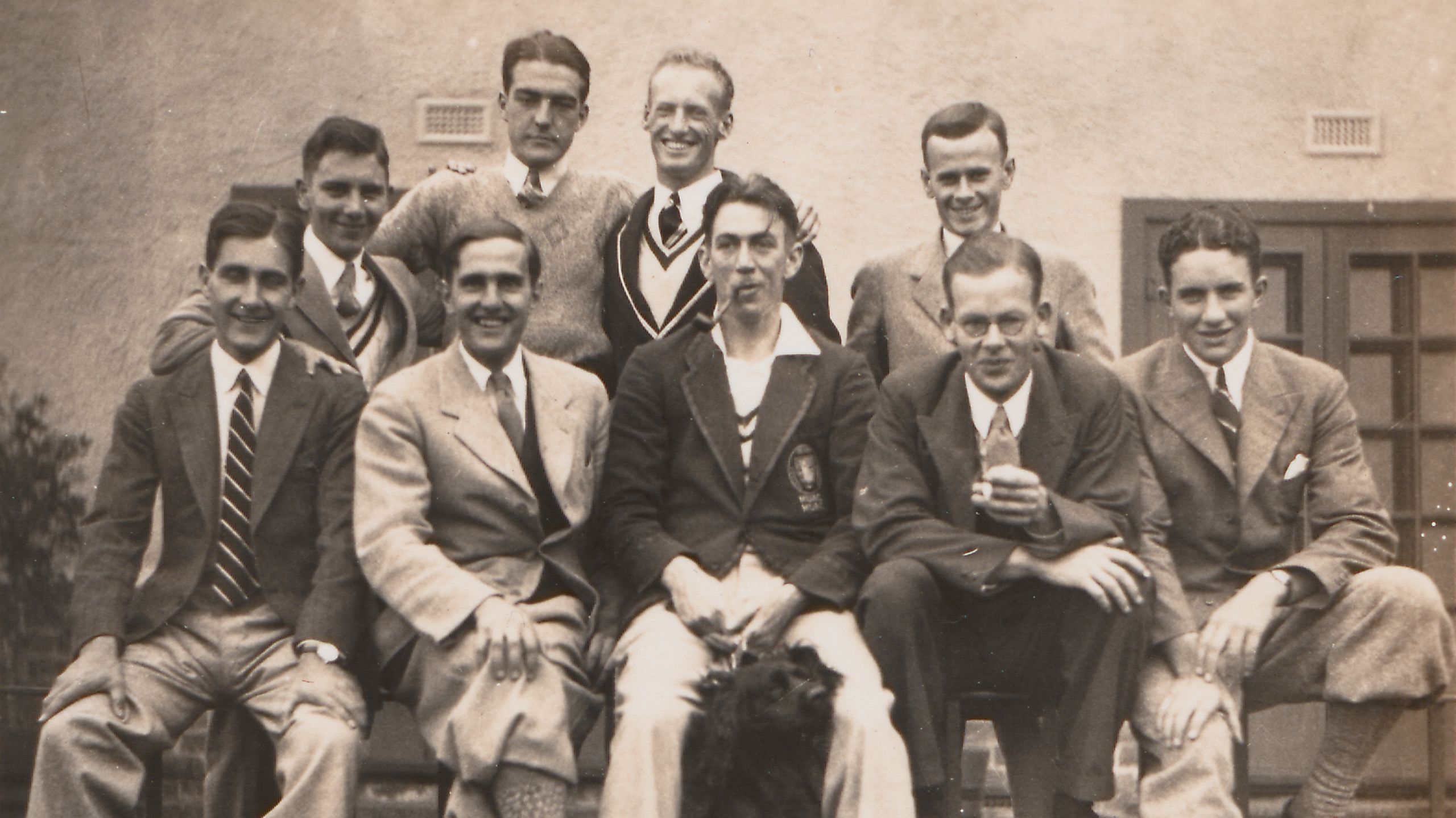Timeline: 150 Years of Trinity

1853
The first Anglican Bishop of Melbourne, the Rt Revd Charles Perry (1807–1891), convenes a meeting on 26 May at which it is resolved that ‘a Collegiate Institution in connection with a Grammar School should be established in this city with a view to affiliating the former with the Melbourne University’.

Archbishop Charles Perry. Artist: Henry Weigall, 1875. Image: State Library of Victoria.
Archbishop Charles Perry. Artist: Henry Weigall, 1875. Image: State Library of Victoria.
1864
A University College Committee, under the chairmanship of the Chief Justice, Sir William Stawell (1815–1889), agrees that ‘steps should be taken for the establishment of a Church of England College in connection with the University, of which a theological institution shall form a part’.

Sir William Stawell. Photographer: Batchelder & O'Neill, c. 1864. Image: State Library of Victoria.
Sir William Stawell. Photographer: Batchelder & O'Neill, c. 1864. Image: State Library of Victoria.
1869
The first Trustees of a proposed Crown Grant are appointed on 28 July: William Foster Stawell, Charles Perry, Hussey Burgh Macartney, James Wilberforce Stephen and William Parkinson Wilson.

1870
Trinity College is founded by Bishop Perry, ‘after the model of the English Colleges of Oxford and Cambridge’. The foundation stone of the first building, the Provost's Lodge, is laid by Bishop Perry on 10 February.

Leonard Terry's original 1869 plan for Trinity College. Only the Warden's Lodge (now Leeper Building) was completed. Image: Trinity College.
Leonard Terry's original 1869 plan for Trinity College. Only the Warden's Lodge (now Leeper Building) was completed. Image: Trinity College.
1871
The trustees drafted the first Constitution and created a 15-member Council which met for the first time on 11 October. The Crown Grant for 'land permanently reserved as a site for Church of England affiliated College purposes' was then issued on 13 November.

The University of Melbourne campus plan showing the original land allocations for the affiliated residential colleges, 1919. Image: University of Melbourne Archives.
The University of Melbourne campus plan showing the original land allocations for the affiliated residential colleges, 1919. Image: University of Melbourne Archives.
1872
The Revd George William Torrance (1835–1907) is appointed as Acting Principal, the first building (now the Leeper Building) is opened, and the first student, Mr John 'Jack' Francis Stretch (later to be ordained and become the first Australian-born Anglican bishop) is admitted to residence.

Revd George William Torrance. Image: Trinity College.
Revd George William Torrance. Image: Trinity College.
1876
Trinity College is affiliated as a College ‘of and within the University of Melbourne’. The first Warden, Dr Alexander Leeper (1848–1934), takes office and introduces a system of College tutorials to supplement University lectures, thereby establishing the College as a centre of academic excellence.

Trinity's first Warden, Dr Alexander Leeper with students in front of the Provost's Lodge. Image: Trinity College Archives.
Trinity's first Warden, Dr Alexander Leeper with students in front of the Provost's Lodge. Image: Trinity College Archives.
1877
Trinity College Theological School is established by the second Bishop of Melbourne, James Moorhouse, to provide theological training and ‘a large and liberal education’ for Anglican clergy. The first meeting of what was soon named the Dialectic Society was held on 27 June, with a debate on 'Women's Rights'.

Revd James Moorhouse. Photographers Foster & Martin, 1886. Image: State Library of Victoria.
Revd James Moorhouse. Photographers Foster & Martin, 1886. Image: State Library of Victoria.
1878
The first residential building, designed by Frederick Wyatt and named Bishops’ (after Perry and Moorhouse) is opened, providing 23 bedrooms, 12 shared studies, a lecturer's flat, four bathrooms, a billiards room (now the Senior Common Room) and a Lecture Hall (now the Cripps Middle Common Room). This allowed the renovation of the original building to house a library, chapel and dining hall.

Newly completed Bishops' Building circa 1878, taken by photographer Charles Nettleton. Image: Trinity College Archives.
Newly completed Bishops' Building circa 1878, taken by photographer Charles Nettleton. Image: Trinity College Archives.
1880
The first Dining Hall is completed to a design by W Pritchard. In 1925, due to the influx of students after the First World War, it was extended to the present stone structure with the original timber roof being retained, and new kitchen facilities added. The Hall was lengthened to the east during the summerbreak of 1954-55.

The original timber Dining Hall, nestled between Bishops' Building and the Warden's Lodge, circa 1900. Image: Trinity College Archives.
The original timber Dining Hall, nestled between Bishops' Building and the Warden's Lodge, circa 1900. Image: Trinity College Archives.
1881
The first intercollegiate sporting competitions were held against Ormond College, which was opened that year. Trinity won the cricket match by 25 runs and then the rowing, but lost the football match 2.9 to 1.6. The first College play was also performed in the Dining Hall, in Latin.

Stage production of Mostellaria, by Trinity College students. Illustrated Australian News, 29 June 1881. Image: State Library of Victoria.
Stage production of Mostellaria, by Trinity College students. Illustrated Australian News, 29 June 1881. Image: State Library of Victoria.
1883
The first female student, Lilian Helen Alexander (pictured in the middle of the back row) is admitted to the College as a non-resident. Trinity becomes the first university college in Australia to admit women.
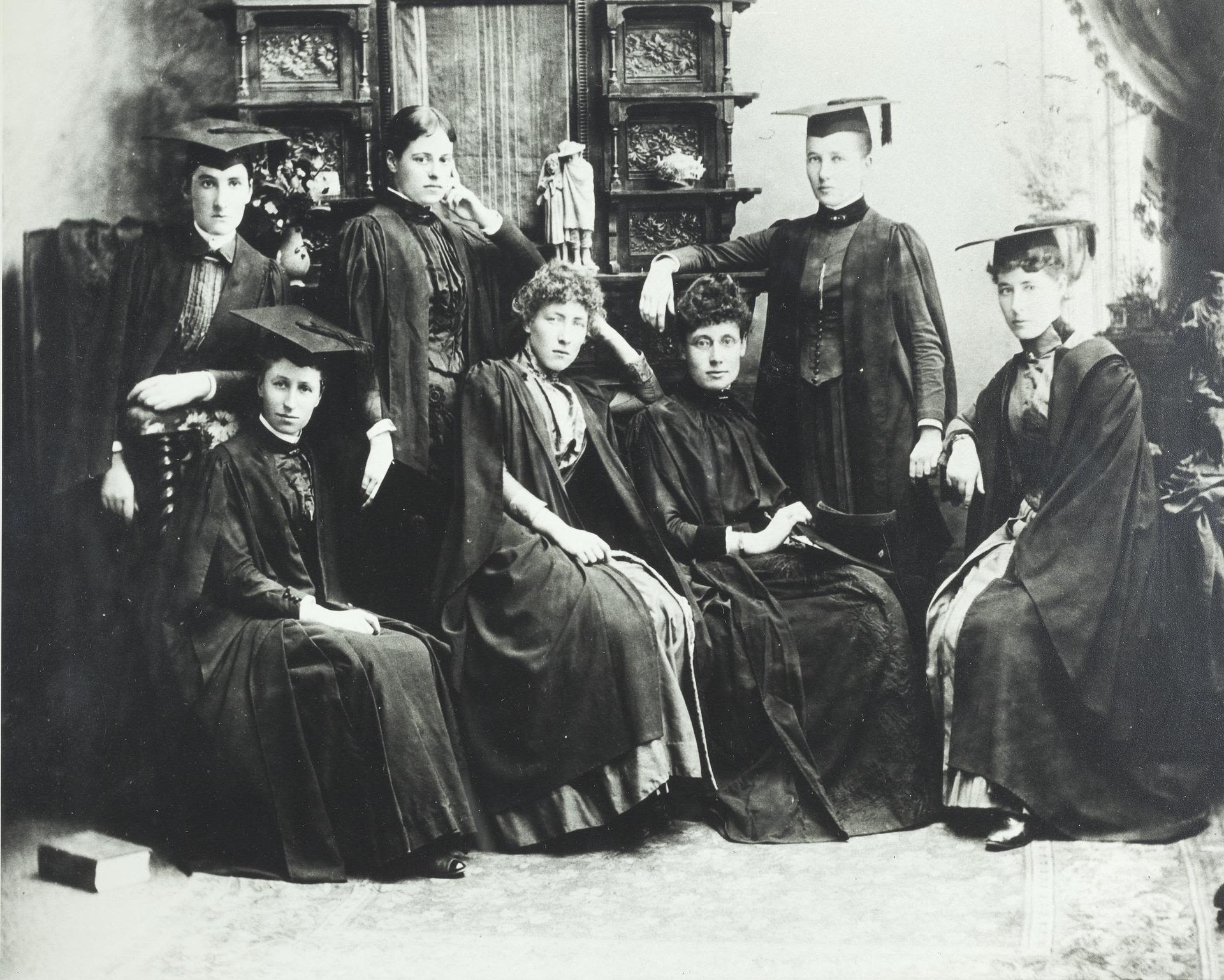
The first cohort of female students to study medicine at the University in 1887 following a successful petition. Image: University of Melbourne Archives.
The first cohort of female students to study medicine at the University in 1887 following a successful petition. Image: University of Melbourne Archives.
1886
Trinity College Ladies' Hostel (later Janet Clarke Hall) is established as the women’s residential section of the College, Australia’s first residential college provision for women. College alumnus and later lecturer Revd Thomas Jollie Smith (TC 1880)(1858–1927) is appointed as the Hostel's first Principal.

Trinity College Ladies' Hostel, the home of the earliest women residents, on Royal Parade, Parkville, 1886-1889. Image: Janet Clarke Hall.
Trinity College Ladies' Hostel, the home of the earliest women residents, on Royal Parade, Parkville, 1886-1889. Image: Janet Clarke Hall.
1888
The Clarke Buildings are completed. Designed by Edmund Blacket and named after the principal donors, Sir William Clarke and his brother Joseph, the building contained bedrooms and studies for 24 students, a new billiards room and the Junior Common Room. Work was completed by Blacket's son Arthur, who added a further 10 student rooms at the west end.

View look north towards the Clarke Building, c. 1900. Image: Trinity College Archives.
View look north towards the Clarke Building, c. 1900. Image: Trinity College Archives.
1891
The Janet Clarke Building of the Trinity College Hostel is opened.

Crowds gather for the laying of the foundation stone of the Janet Clarke Building in 1891. Image: Trinity College Archives.
Crowds gather for the laying of the foundation stone of the Janet Clarke Building in 1891. Image: Trinity College Archives.
1914
With the outbreak of the First World War, eager students and alumni enlist to serve in the armed forces. Trinity's residential community of approximately 50 students is reduced to a mere handful still in residence. In total, almost 300 alumni served during the conflict, 42 of whom gave their lives. In the aftermath, a war memorial of photos of the fallen is installed in the Common Room in Clarke Building.

War memorial of fallen alumni installed in the Junior Common Room in Clarke Building in the early 1920s. Image: Trinity College Archives.
War memorial of fallen alumni installed in the Junior Common Room in Clarke Building in the early 1920s. Image: Trinity College Archives.
1917
After delays during the war years due to shortages in supplies and labour, the College Chapel is consecrated on 24 November 1917. Built to a design by Tasmanian architect Alexander North and funded by a donation from Mr John Sutcliffe Horsfall, in memory of his daughter Edith Carington, the Chapel replaces an earlier chapel situated in the ground floor of the Warden's Lodge since the 1870s.

The Horsfall Chapel, completed in 1917. Image: Trinity College Archives.
The Horsfall Chapel, completed in 1917. Image: Trinity College Archives.
1918
Mr (later Sir) John Clifford Valentine Behan (1881–1957) is appointed as the second Warden. An alumnus of Trinity, Behan was Victoria's inaugural Rhodes Scholar in 1904.

Returning Trinity alumnus, John 'Jock' Behan, in 1919 shortly after his commencement as Trinity's second Warden. Image: University of Melbourne Archives.
Returning Trinity alumnus, John 'Jock' Behan, in 1919 shortly after his commencement as Trinity's second Warden. Image: University of Melbourne Archives.
1920
To meet the demand of returning soldiers from the First World War seeking entry to Trinity, a temporary residential barracks is hastily erected on the northern side of Clarke Building, known as the Wooden Wing. It would remain for forty years, only being demolished during the summer break of 1962-63.
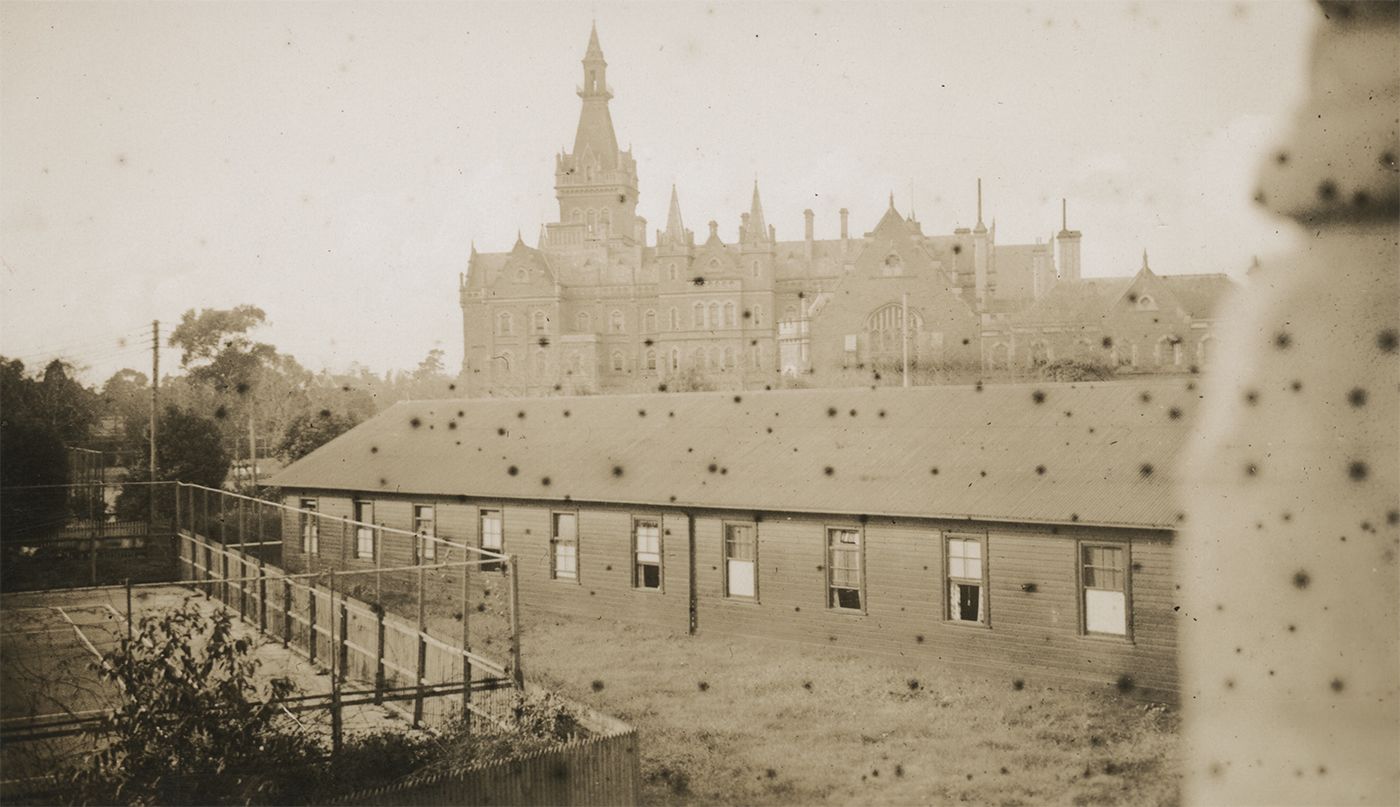
Erected as a temporary structure at the end of the First World War, the Wooden Wing would finally be demolished 40 years later, in 1962. Image: Trinity College Archives.
Erected as a temporary structure at the end of the First World War, the Wooden Wing would finally be demolished 40 years later, in 1962. Image: Trinity College Archives.
1921
The Trinity College Women's Hostel is renamed Janet Clarke Hall.

The Janet Clarke Building, later renamed Janet Clarke Hall, from Royal Parade, c. 1910. Image: Trinity College Archives.
The Janet Clarke Building, later renamed Janet Clarke Hall, from Royal Parade, c. 1910. Image: Trinity College Archives.
1924
The Trinity College (Melbourne) Trusts Corporation, a company limited by guarantee, is formed to manage endowment funds.

1927
The first Trinity College Act is passed by the Victorian Parliament, under which the lands of the Crown Grant are transferred from the trustees to the Trusts Corporation.

Taxis line the main driveway during Commencement in 1927. Image: Trinity College Archives.
Taxis line the main driveway during Commencement in 1927. Image: Trinity College Archives.

1931
In 1931, in an effort to put an end to an ongoing debate around initiations, two students – Colin Juttner and Thomas Harold 'Hal' Oddie – established a playful steeple-chase around the college grounds for 'fresher' students. Known as 'Juttoddie', a college tradition was born that continues to the present.

Colin Juttner (TC 1929), Francis Denys Cumbrae-Stewart (TC 1926) and Thomas 'Hal' Oddie (TC 1929) posing on the lawns in front of Bishops' Building at the inaugural College steeplechase, 'Juttoddie'. Image: Trinity College Archives.
Colin Juttner (TC 1929), Francis Denys Cumbrae-Stewart (TC 1926) and Thomas 'Hal' Oddie (TC 1929) posing on the lawns in front of Bishops' Building at the inaugural College steeplechase, 'Juttoddie'. Image: Trinity College Archives.
1935
The Behan residential building is opened. It is unusual for the time in providing larger rooms that served both as bedroom and study, and is the only Trinity building to be based on the Oxbridge 'staircase' model rather than corridors. The building was extended slightly in 1964.
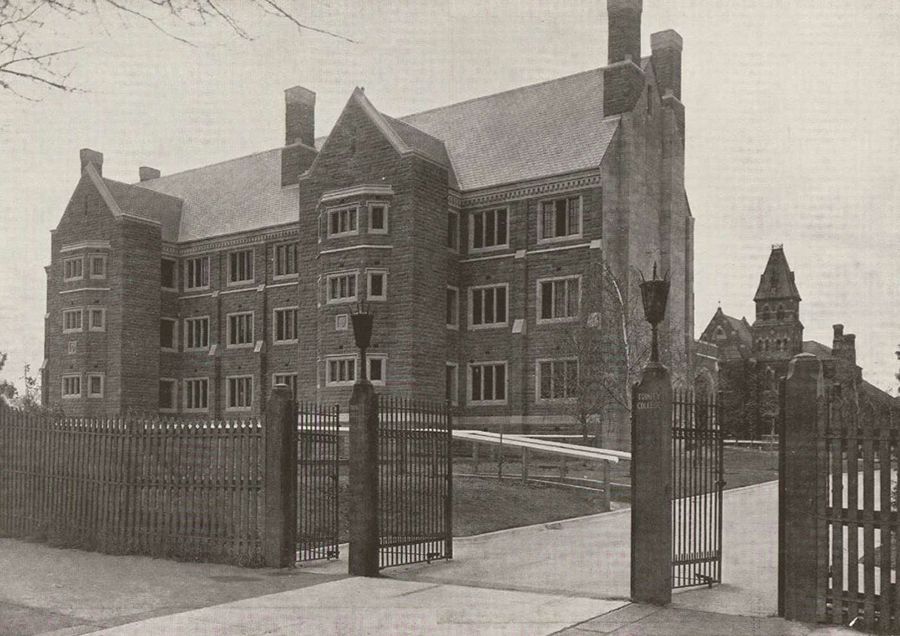
Newly completed Behan Building, taken from outside the main gates on Royal Parade, c. 1935. Image: Trinity College.
Newly completed Behan Building, taken from outside the main gates on Royal Parade, c. 1935. Image: Trinity College.
1942
During World War II, the Leeper building is used as the headquarters of the Royal Australian Air Force School of Administration and Special Duties, and up to 225 Air Force trainees are barracked in the College. Resident students are requested to share bedrooms to provide the necessary accommodation.

Former Senior Student James Stewart Noel Harris (TC 1925) returns to Trinity, now as Chief Instructor of the RAAF School of Administration, after the school moves from Ascot Vale to Trinity College, in early 1942. Image: Australian War Memorial.
Former Senior Student James Stewart Noel Harris (TC 1925) returns to Trinity, now as Chief Instructor of the RAAF School of Administration, after the school moves from Ascot Vale to Trinity College, in early 1942. Image: Australian War Memorial.
1946
Mr Ronald William Trafford Cowan (1914–1964) is appointed as the third Warden.

Ronald Cowan with his family in the driveway of the Deanery. Image: Trinity College Archives.
Ronald Cowan with his family in the driveway of the Deanery. Image: Trinity College Archives.
1957
The second Trinity College Act is passed, granting the College power to mortgage or otherwise deal with its land independently, although only with the assent of the state Governor-in-Council.

Cars parked in front of Behan Building, c. 1950s. Image: Trinity College Archives.
Cars parked in front of Behan Building, c. 1950s. Image: Trinity College Archives.
1959
The Memorial Building, a residential building built partially with donations given for a memorial to College members killed during World War II, and known almost from the outset as 'Jeopardy', is completed.

Newly completed Memorial Building, subsequently known as 'Jeopardy', c. 1958. Image: Trinity College Archives.
Newly completed Memorial Building, subsequently known as 'Jeopardy', c. 1958. Image: Trinity College Archives.
1961
Janet Clarke Hall becomes a separate College, although women continue to participate in tutorials at Trinity.

View looking north-west towards Janet Clarke Hall. Image: Trinity College Archives.
View looking north-west towards Janet Clarke Hall. Image: Trinity College Archives.
1965
Professor Robin Lorimer Sharwood (1931-2015) takes office as the fourth Warden on 1 June 1965, aged just 33 years old. His Wardenship is noted for his refined aesthetic tastes and a desire to increase the visual arts and culture at college.

Dr (later Professor) Robin Sharwood, c. 1965. Image: Trinity College Archives.
Dr (later Professor) Robin Sharwood, c. 1965. Image: Trinity College Archives.
1965
Built in two stages, the Cowan residential building is opened, providing more than 60 new rooms. It is named after the third Warden Ronald Cowan.
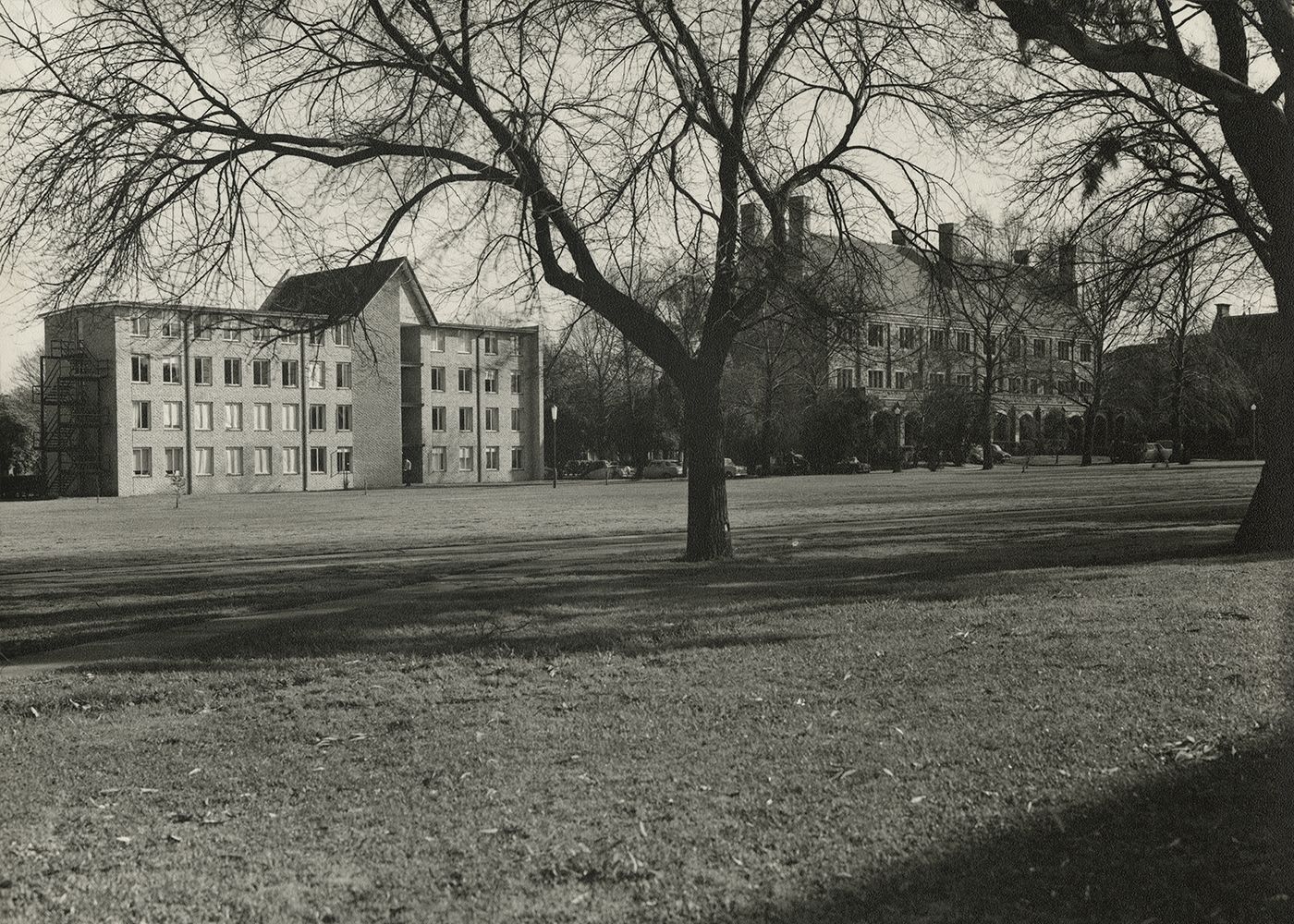
The first stage of Cowan Building stands on the western edge of the Bulpadock, 1962. Image: Trinity College Archives.
The first stage of Cowan Building stands on the western edge of the Bulpadock, 1962. Image: Trinity College Archives.
1974
Women are admitted to full co-residence at Trinity College. The Revd Dr Evan Laurie Burge commences as the fifth Warden.

Revd Dr Evan Burge with his family at Trinity College, 1974. Image: Trinity College Archives.
Revd Dr Evan Burge with his family at Trinity College, 1974. Image: Trinity College Archives.
1977
Groups of students had sung in Chapel since the earliest days, but with the appointment of Professor Peter Dennison as the first professional Director of Music, the new Choir of Trinity College in its present form sang its first Choral Evensong in March.

Inaugural Director of Music Peter Dennison with the choir in the Chapel, 1978. Image: Trinity College Archives.
Inaugural Director of Music Peter Dennison with the choir in the Chapel, 1978. Image: Trinity College Archives.
1979
The third Trinity College Act is passed by the Victorian Parliament, dissolving the Trinity College (Melbourne) Trusts Corporation, incorporating the College in its own right, and providing a new constitution.

1983
The Trinity College Foundation – the arm of the College seeking philanthropic support – is founded to foster and encourage the College’s commitment to access and equity.

Peter Field (TC 1961) and Nicholas Alexander (TC 1961) perform at the Foundation Dinner in the Dining Hall, in 1986. Image: Trinity College Archives.
Peter Field (TC 1961) and Nicholas Alexander (TC 1961) perform at the Foundation Dinner in the Dining Hall, in 1986. Image: Trinity College Archives.
1983
Gilbert and Sullivan's Trial by Jury was performed as the first annual College Musical.

Students performing in 'Trial by Jury' in the Dining Hall, 1983. Image: Trinity College.
Students performing in 'Trial by Jury' in the Dining Hall, 1983. Image: Trinity College.
1989
Trinity College Foundation Studies (originally Trinity Education Centre) is established (and began in 1990) to provide a first-class, preparatory pathway for talented overseas students seeking entry to the University of Melbourne.
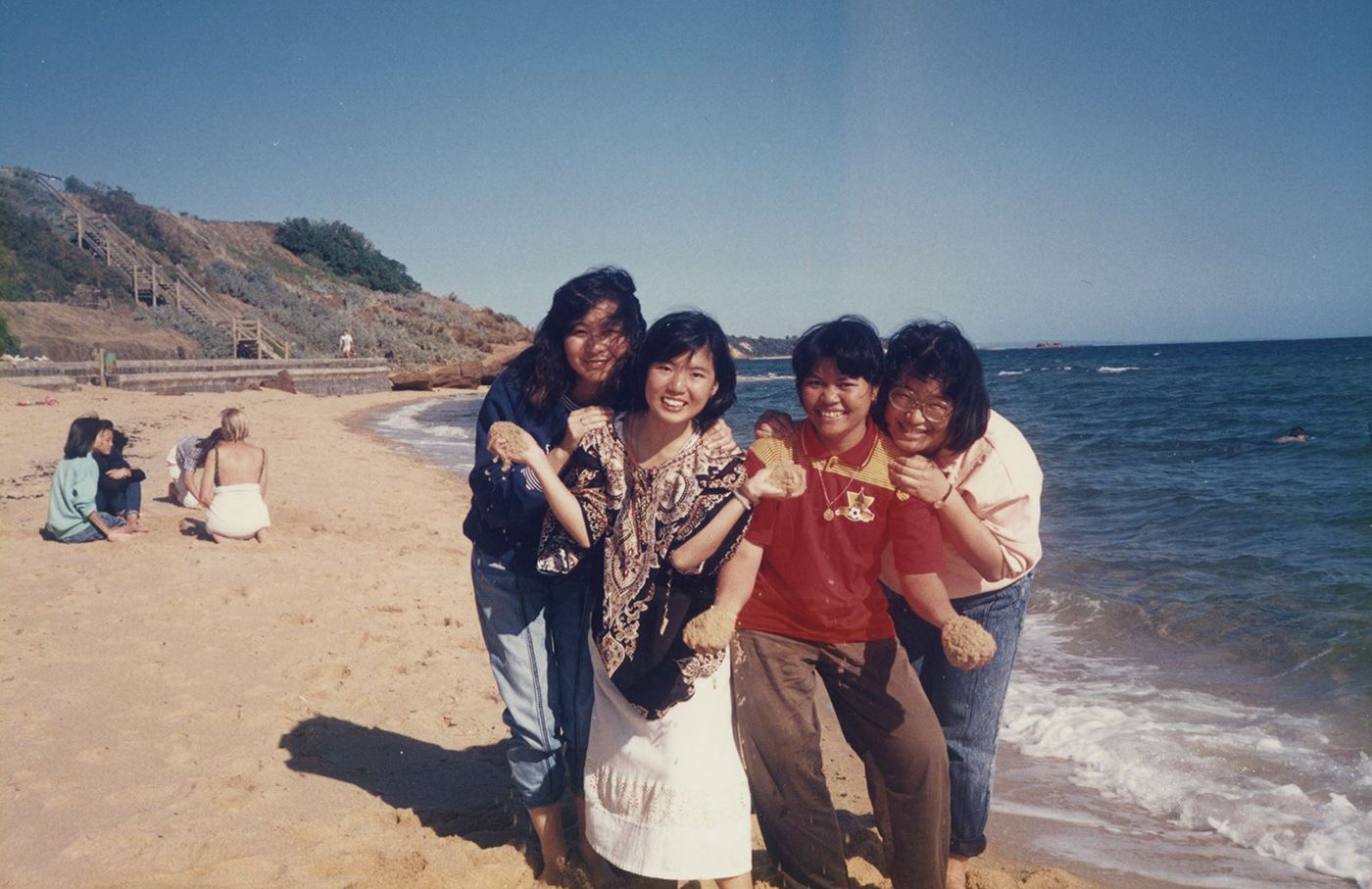
Foundation Studies students making the most of the Australian experience, early 1990s. Image: Trinity College Archives.
Foundation Studies students making the most of the Australian experience, early 1990s. Image: Trinity College Archives.
1992
A new constitution is adopted, under which the governance structure is modified to include a new Board of Management (commencing in 1996) appointed by the Council, with the Council remaining as a representative body of review and consultation.

1996
The Evan Burge building, including a dedicated library, tutorial rooms, drama space and a lecture theatre, is opened.

Evan Burge Building. Image: Trinity College.
Evan Burge Building. Image: Trinity College.
1997
Professor Donald Markwell is appointed sixth Warden.

Trinity's sixth Warden, Dr Donald Markwell, talking with students Belinda Wong and Sarah Nosworthy near the College Oak. Image: Trinity College Archives.
Trinity's sixth Warden, Dr Donald Markwell, talking with students Belinda Wong and Sarah Nosworthy near the College Oak. Image: Trinity College Archives.
2000
The Trinity College Learning Innovation Centre (TCLIC) is set up to explore developments in education, with a particular emphasis on the use of technology to enhance educational outcomes.

2001
The first two residential scholarships for Indigenous students are established. Sana Nakata (TC 2001) and Lily Brophy (TC 2001) commence as the inaugural two recipients.
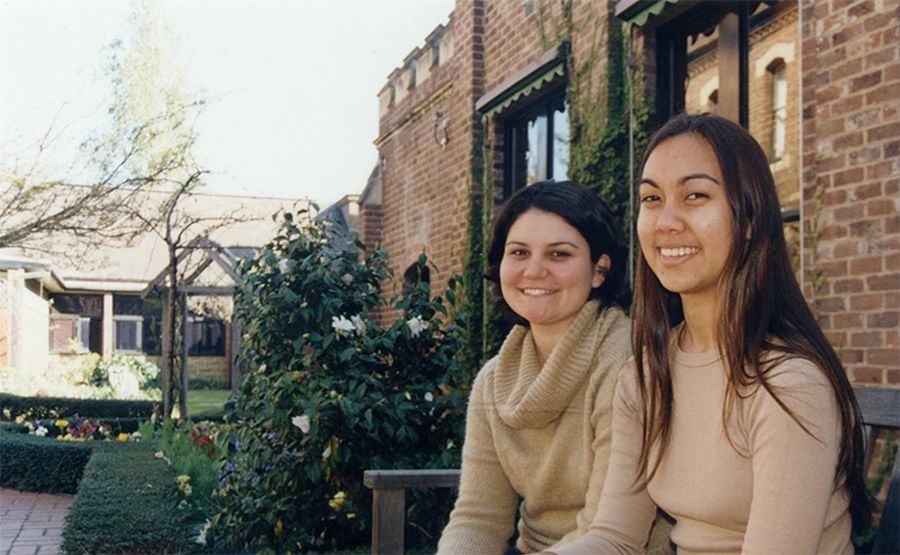
Lily Brophy (TC 2001; left) and Sana Nakata in the Sharwood Courtyard. Image: Trinity College.
Lily Brophy (TC 2001; left) and Sana Nakata in the Sharwood Courtyard. Image: Trinity College.
2006
The ‘No Bul Barbershop’ group is founded by Tutor Angus Turner, later adopting the name 'Trinity Tiger Tones' and appearing on Australia's Got Talent in 2012.

The Tiger Tones performing at The Toff in Town in Melbourne, c. 2010. Image: Harrison Wraight (TC 2006).
The Tiger Tones performing at The Toff in Town in Melbourne, c. 2010. Image: Harrison Wraight (TC 2006).
2007
The Revd Dr Andrew B McGowan commences as the seventh Warden.

Revd Dr Andrew McGowan. Image: Trinity College.
Revd Dr Andrew McGowan. Image: Trinity College.
2008
A new residential building known as 'Gourlay' is opened on the site of the old 'woodheap', providing 22 ensuite rooms for postgraduates and senior students, a tutor's flat, two visiting scholar apartments, and a multi-purpose basement facility.

A new era of student recreational spaces with the opening of the Gourlay Building. Image: Trinity College.
A new era of student recreational spaces with the opening of the Gourlay Building. Image: Trinity College.
2008
In the second semester of 2008, residential students Grace Mollard and Gina Tan found an all-female acapella group, called The Candy Stripes.

The Candystripes in the College Chapel following a performance in 2015.
The Candystripes in the College Chapel following a performance in 2015.
2009
Trinity’s sustainability policy is formulated and the name planitgreen, Trinity’s Sustainability Projects, is adopted. Rainwater tanks with a capacity of 800,000 litres are installed under the Bulpadock. A revised constitution is adopted by the Council.

Watertanks being installed underneath the Bulpadock. Image: Trinity College.
Watertanks being installed underneath the Bulpadock. Image: Trinity College.
2010
The renovated and expanded Trinity College Theological School is dedicated, including construction of a new lecture wing and refurbishment of the existing Old Warden’s Lodge (OWL).

Generous supporters Robert Cripps (right) and daughter Amy Tennent (TC 1996) with the designs of the proposed new Theological School wing, completed in 2010. Image: Trinity College.
Generous supporters Robert Cripps (right) and daughter Amy Tennent (TC 1996) with the designs of the proposed new Theological School wing, completed in 2010. Image: Trinity College.
2011
The Trinity Institute is established to offer leadership programs for high school students, professional learning for teachers and open learning opportunities for all.

Students embrace the recently introduced iPad leaning program. Image: Trinity College.
Students embrace the recently introduced iPad leaning program. Image: Trinity College.
2012
The Dining Hall and kitchens are refurbished, adding heating and cooling, new roof lantern and an informal dining space facing Sharwood Court.

A renovation of the Dining Hall allowed more light to filter into this significant 'heart' of the college, in addition to increased informal dining in the adjoining cafe area. Image: Trinity College.
A renovation of the Dining Hall allowed more light to filter into this significant 'heart' of the college, in addition to increased informal dining in the adjoining cafe area. Image: Trinity College.
2014
The Theological School becomes an independent college of the new University of Divinity (formed from the Melbourne College of Divinity in 2012).

Dean of the Theological School, the Revd Dr Dorothy Lee with postgraduate students Melissa Clark and Paul Daniels on the Bulpadock near the Chapel. Image: Trinity College.
Dean of the Theological School, the Revd Dr Dorothy Lee with postgraduate students Melissa Clark and Paul Daniels on the Bulpadock near the Chapel. Image: Trinity College.
2014
Named in honour of retiring Chair of the Board, Bill Cowan (TC 1963), the inaugural 'Alumni of the Year' Award is established.
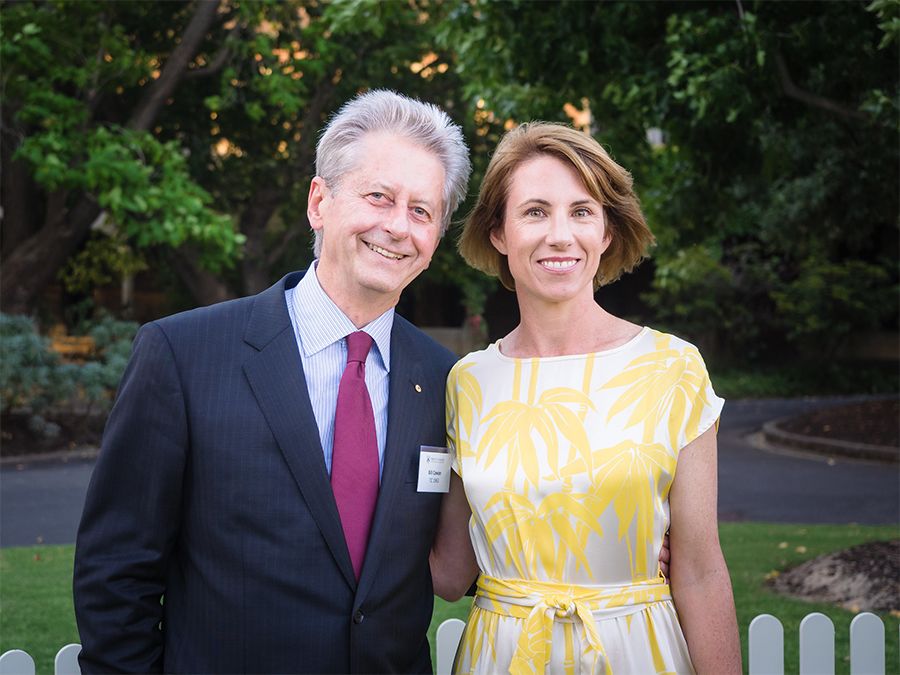
Bill Cowan (TC 1963) with the 2017 recipient of the 'Alum of the Year' award, acclaimed poet, essayist and novelist Dr Lisa Gorton (TC 1990). Image: Trinity College.
Bill Cowan (TC 1963) with the 2017 recipient of the 'Alum of the Year' award, acclaimed poet, essayist and novelist Dr Lisa Gorton (TC 1990). Image: Trinity College.
2015
Professor Kenneth Hinchcliff is installed as the eighth Warden.

Professor Ken Hinchcliff (TC 1976) is installed as Trinity's eighth Warden by the President of the College Council, Archbishop Philip Freier. Image: Trinity College.
Professor Ken Hinchcliff (TC 1976) is installed as Trinity's eighth Warden by the President of the College Council, Archbishop Philip Freier. Image: Trinity College.

2016
The Gateway Building opens for teaching in August, before being formally opened by the Governor-General at the start of 2017.

The Gateway Building, designed by alumni architectural firm McIldowie Partners, opens in August 2016. Image: Trinity College.
The Gateway Building, designed by alumni architectural firm McIldowie Partners, opens in August 2016. Image: Trinity College.
2016
The first Indigenous Higher Education Conference was held at Trinity. As part of the conference, the first exhibition in the new Sir Joseph Burke Gallery in the Gateway building was held, showcasing the College's Indigenous collection.

Exhibitions of Indigenous art in the Sir Joseph Burke Gallery become a staple part of Trinity's outward-facing engagement. Warden Ken Hinchcliff chats with lender Anita Castan at the opening of 'Revealed', a loan collection of early barks from the communities Yirrkala and Milingimbi in the Northern Territory. Image: Trinity College.
Exhibitions of Indigenous art in the Sir Joseph Burke Gallery become a staple part of Trinity's outward-facing engagement. Warden Ken Hinchcliff chats with lender Anita Castan at the opening of 'Revealed', a loan collection of early barks from the communities Yirrkala and Milingimbi in the Northern Territory. Image: Trinity College.
2018
A new strategic plan called ‘Unlocking Exceptional Promise’ provides for an expanded College and generous scholarship program.

2020
A new residential wing is opened in the north-east precinct of Trinity’s main campus and is subsequently named the Dorothy Jane Ryall building (‘Dorothy’). Dorothy Jane Ryall was a matron at Trinity from the late 1920s until her death in 1942. One of the buildings that previously stood on the site of the current 'Dorothy' was referred to by the same name in recognition of Ryall.

Federal Education Minister, the Honourable Dan Tehan (TC 1987), cuts the ribbon with Trinity Warden Ken Hinchcliff (TC 1976) at the opening of the Dorothy Jane Ryall Building. Image: Trinity College.
Federal Education Minister, the Honourable Dan Tehan (TC 1987), cuts the ribbon with Trinity Warden Ken Hinchcliff (TC 1976) at the opening of the Dorothy Jane Ryall Building. Image: Trinity College.
2020-2021
The COVID-19 pandemic hits Australia in early 2020. The Theological School and Pathways School move to online learning immediately and continue teaching this way for most of 2020, 2021 and into 2022. Melbourne becomes the most 'locked down' place in the world, with tough restrictions implemented. The Residential College enforces a 'lock in' of residential students during 2020.

A lone student sits in the window of their bedroom in Jeopardy as the sun sets over the Bulpadock during the COVID-19 lockdowns. Image: Trinity College Archives.
A lone student sits in the window of their bedroom in Jeopardy as the sun sets over the Bulpadock during the COVID-19 lockdowns. Image: Trinity College Archives.
2022
Trinity College celebrates its 150th anniversary.

College news
2022 snapshot






